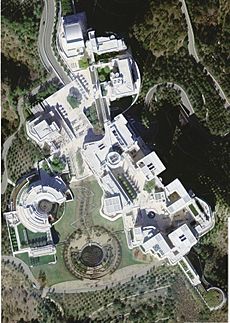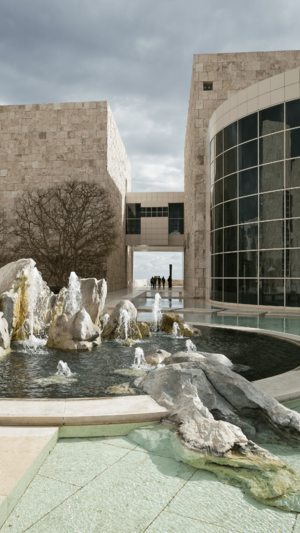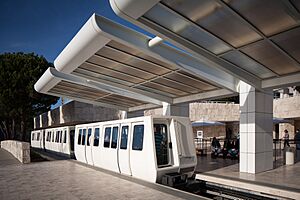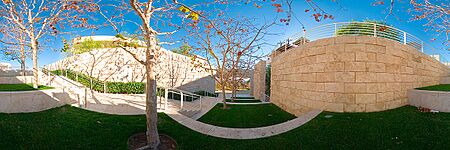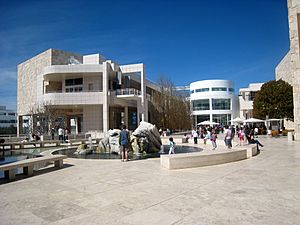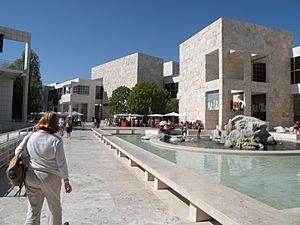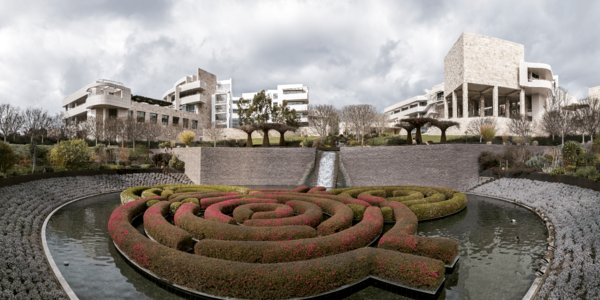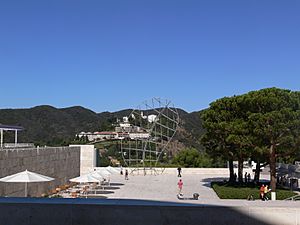Getty Center facts for kids

The Getty Center campus as viewed from the south
|
|
| Lua error in Module:Location_map at line 420: attempt to index field 'wikibase' (a nil value). | |
| Established | December 16, 1997 |
|---|---|
| Location | 1200 Getty Center Drive Los Angeles, California |
| Type | Art museum |
| Visitors | >1,400,000 (2019) |
| Architect | Richard Meier |
| Public transit access | |
The Getty Center is a famous place in Los Angeles, California. It's home to the Getty Museum and other important art programs. This amazing place cost about $1.3 billion to build. It opened on December 16, 1997. People love it for its cool buildings, beautiful gardens, and awesome views of Los Angeles.
The Getty Center sits on top of a big hill. Visitors park at the bottom and ride a special tram up to the museum. This tram is like a small train pulled by cables.
Located in the Brentwood area of Los Angeles, the Getty Center is one of two places for the J. Paul Getty Museum. It welcomes about 1.8 million visitors every year. The other location is the Getty Villa in Pacific Palisades.
At the Getty Center, you can see European paintings, drawings, and sculptures made before the 1900s. There are also old books with beautiful pictures (illuminated manuscripts) and decorative art. Plus, you can explore photographs from the 1830s to today, from all over the world. Outside, there are sculptures on terraces and in gardens. The large Central Garden was designed by artist Robert Irwin. One famous painting you can see is Irises by Vincent van Gogh.
The entire campus was designed by architect Richard Meier. It also has the Getty Research Institute (GRI), the Getty Conservation Institute, the Getty Foundation, and the J. Paul Getty Trust. The buildings were made with special features to stay safe during earthquakes and fires.
Contents
Where is the Getty Center?
The Getty Museum first started in J. Paul Getty's house in Pacific Palisades in 1954. He added a museum part to his house. In the 1970s, Getty built a copy of an Italian villa on his land to hold his growing art collection. This new museum opened in 1974.
After Getty passed away in 1976, his property became part of the Getty Trust for museum use. But the art collection grew too big for the site, which is now called the Getty Villa. So, they looked for a new place that was easier for people in Los Angeles to visit.
In 1983, they announced they had bought land for the new center. It's a 24-acre campus on a 110-acre site in the Santa Monica Mountains. It sits above Interstate 405 and is surrounded by 600 acres of natural land. The top of the hill is 900 feet above sea level. On a clear day, you can see the Los Angeles skyline, the San Bernardino Mountains, the San Gabriel Mountains, and even the Pacific Ocean.
The Getty Center cost about $1.3 billion to build. This included money for construction, land, equipment, and safety measures. In 1984, Richard Meier was chosen as the architect. Construction began in August 1989. The center finally opened to the public on December 16, 1997.
After the Getty Center opened, the Getty Villa closed for big updates. It reopened in 2006. Now, it focuses on art from ancient Greece, Rome, and Etruria. The museum shows its collections at both the Getty Center and the Getty Villa.
Amazing Architecture
Meier designed the Getty Center using two main lines that cross each other. These lines help organize the campus and show where different buildings are. The art galleries are along one line, and the offices are along the other. Meier made sure you could see these lines clearly as you walk around.
The buildings at the Getty Center are made from concrete and steel. They are covered with a special stone called travertine or with aluminum. About 1.2 million square feet of travertine was used to build the center.
Many fountains around the campus create a peaceful sound. Benches and fences were added around the main plaza fountains. This helps keep visitors from wading into the water.
The north end of the complex has a round grassy area. This can be used as a heliport in emergencies. The south end has a garden with succulent plants and cacti. The hills around the center are planted with California Live Oak trees.
The museum has a seven-story underground parking garage. It has over 1,200 parking spaces. There is a fee to park there.
An automated tram, called the "Getty Center Tram", takes visitors from the parking garage at the bottom of the hill to the museum at the top. The tram runs all day long. The roof of the museum also has an outdoor sculpture garden.
Arrival and Main Entrance
Visitors usually arrive at the tram station. This station is in a plaza between the office buildings and the museum entrance. A large set of steps leads to the main doors of the rotunda building. This building has information desks, two theaters for watching videos, and museum shops. It also has a grand staircase that leads to the paintings on the second floor of each art pavilion.
The rotunda opens to a terrace on the south side. This terrace connects all five of the museum's art pavilions. A separate building to the west of the arrival plaza has a cafeteria and a restaurant. Next to the restaurant is a stone arch. This arch separates the museum from the Getty Research Institute. Stairs from the terrace lead down to the Central Garden.
The J. Paul Getty Museum
The J. Paul Getty Museum is one of the most visited museums in the United States. It welcomes about 1.8 million visitors each year. The art collection at the Getty Center includes European paintings, drawings, and sculptures made before the 1900s. It also has illuminated manuscripts and decorative arts. You can also see American and European photographs from the 1800s and 1900s.
Some famous paintings you can see include:
- Arii Matamoe (The Royal End) by Paul Gauguin (1892). The museum bought this painting, and it was a very important moment for their collection. The title means "noble" and "sleeping eyes" in Tahitian, which suggests "death."
- Irises by Vincent van Gogh (1889). The museum bought this painting in 1990.
- Portrait of a Halberdier by Pontormo (1528–1530). When the museum bought this painting in 1989, it set a new record for an Old Master painting.
- A copy of Portrait of Louis XIV by the workshop of Hyacinthe Rigaud (after 1701). This painting is very large, measuring 114 by 62-5/8 inches.
The Getty's large collection of photographs is on the lower level of the west pavilion.
The museum building has a three-level base that is not open to the public. This area is for staff and storage. On top of this base are five public, two-story towers. These are called the North, East, South, West, and Exhibitions Pavilions. The Exhibitions Pavilion holds art collections that travel to the museum and other artworks.
The permanent collection is shown in the other four pavilions in time order. The North Pavilion has the oldest art, and the West Pavilion has the newest. The first-floor galleries in each pavilion show art that is sensitive to light. This includes illuminated manuscripts, furniture, or photographs. The second-floor galleries have special skylights that let natural light shine on the paintings.
The second floors are connected by glass bridges and open terraces. From these spots, you can see the hills around the museum and the central plaza. Sculptures are also displayed outside the buildings on various terraces and balconies. The lower level has a public cafeteria and the photography galleries.
The museum offers many programs. These include art shows, family workshops, school visits, performances, talks, and tours. There are also brochures for young visitors. These brochures help kids go on a scavenger hunt for exhibits and learn fun facts about the art.
The Central Garden
The 134,000-square-foot Central Garden at the Getty Center was created by artist Robert Irwin. Planning for the garden began in 1992, and it was finished in December 1997.
Irwin said that the Central Garden "is a sculpture in the form of a garden, which aims to be art." Water is a very important part of the garden. A fountain near the restaurant flows towards the garden. It seems to fall into a small cave on the north garden wall. The water then flows down the hillside into a pool filled with azaleas. The designers put rocks and boulders in the stream to make different sounds from the flowing water.
A stream lined with trees goes down to a plaza. A walkway crosses over the stream, which continues through the plaza. It then goes over a stone waterfall into a round pool. A maze of azaleas floats in this pool. Around the pool are several special gardens. More than 500 different types of plants are used in the Central Garden. The plants are "always changing, never twice the same."
In 2007, an outdoor sculpture garden was added. It's called the "Lower Terrace Garden." It's on the west side of the central garden, below the Getty Research Institute building.
Getty Research Institute (GRI)
The Getty Research Institute (GRI) works to "further knowledge and advance understanding of the visual arts." Its research library has over 900,000 books, magazines, and auction catalogs. It also has special collections and two million photographs of art and buildings. The GRI also holds exhibitions, publishes books, and has a program for visiting scholars.
At the Getty Center, the GRI is located to the west of the museum. The round building surrounds a beautiful garden. The main entrance of the GRI is connected by a terrace to the museum's main arrival court. Outdoor sculptures are placed along this path. The GRI has one art gallery on its entrance level that is open to the public.
Other Important Offices
Richard Meier also designed three other buildings near the north end of the campus. These buildings are set at a slight angle from the museum's main line. The building furthest north is an auditorium. Next to it is the North Building, and the East Building sits between the North Building and the rotunda. The main entrance to the East Building has two round towers that hold its elevators. A bridge connects the East Building's main entrance to the walkway that links the auditorium and North Buildings to the rotunda.
These buildings house the Getty Conservation Institute (GCI), the J. Paul Getty Trust, and the Getty Foundation. These buildings are usually closed to the public. However, special events are sometimes held in the auditorium. They are connected to the museum by landscaped terraces and a glass walkway from the main rotunda.
The GCI started in 1985. It helps people who work to preserve art and buildings. It does this through scientific research, education, and training. It also shares its findings with others. The GCI works on both art conservation and architectural conservation.
The Getty Foundation gives money to projects that help people understand and preserve visual arts. It also runs the Getty Leadership Institute, which trains museum leaders. Its offices are north of the museum. The J. Paul Getty Trust, which oversees all the Getty organizations, also has offices there.
Staying Safe from Disasters
Earthquakes
Even though the Getty Center's location was thought to be safe from earthquakes, the 1994 Northridge earthquake happened while it was being built. This earthquake caused small cracks in the steel frame. Because of this, the steelwork throughout the site was made stronger. The center's buildings are now designed to survive a 7.5 magnitude earthquake.
Fires
The Getty Center's architect, Richard Meier, made sure the buildings were very safe from fire. The Getty describes itself as "the safest place for art during a fire." The buildings are made of travertine, concrete, and protected steel. Travertine was chosen because it resists fire.
The buildings are surrounded by travertine plazas with well-watered plants. This helps slow down the spread of fire. Oak trees are regularly trimmed to keep their branches high off the ground. Flammable plants were removed from the slopes around the center. Fire-resistant plants were added instead. Every year, a herd of goats is rented to clear brush on the surrounding hills. The roofs of the Getty buildings are also covered with fire-resistant crushed stone.
At the north end of the center, there is a tank holding 1 million gallons of water. There is also a grassy helipad. This allows helicopters to collect water in case of a fire. The ramp from the entry plaza to the museum was built so a fire truck can drive over it.
Inside, the walls are made of strong concrete or fire-protected steel. They have automatic fire doors that can seal off parts of the building. The air system is designed to keep smoke from entering the building if there's a fire outside. The sprinkler system is a "last resort." It is designed to protect the valuable artwork from both fire and water damage.
In 2017, the Skirball Fire almost reached the Getty Center. A burning ember landed on the Getty hill. But the damp ground, soaked with water from the Getty's irrigation pipes, stopped the fire from spreading. The fire department put it out with no damage to the center. In January 2025, during the Southern California wildfires, the Getty Center was in an area where people had to leave their homes because of the spreading Palisades Fire.
Images for kids
See also
 In Spanish: Getty Center para niños
In Spanish: Getty Center para niños


